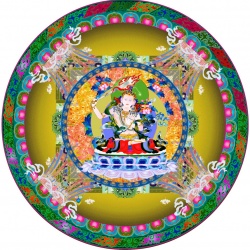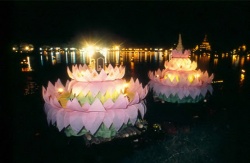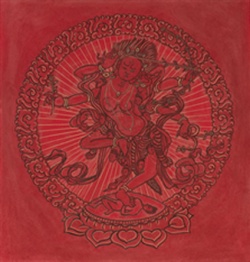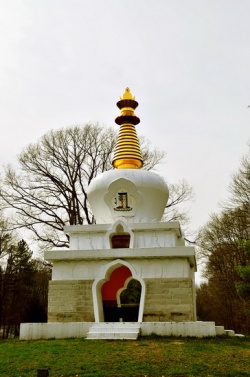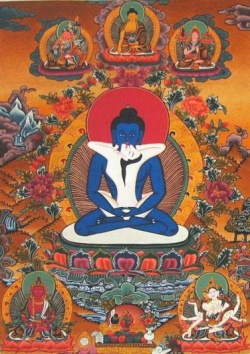Śrāvaṇa
Śrāvaṇa (Sanskrit: श्रावण) is a month of the Hindu calendar. In India's national civil calendar, Śrāvaṇa is the fifth month of the Hindu year, beginning in late July and ending in the third week of August. In the Tamil calendar, it is known as Āadi (Tamil: ஆடி) and is the fifth month of the solar year. Śrāvaṇa begins with the Sun's entry into Leo. In lunar religious calendars, Śrāvaṇa begins on the new moon and is the fifth month of the year. Srabon (Bengali: শ্রাবণ; also spelt Sravan) is the fourth month of the Bengali calendar. This is also the 2nd month of Varsha (rainy) season.
Festivals
Shravana(jupaka) is considered to be a holy month in the Hindu calendar due to the many festivals that are celebrated during this time. Krishna Janmashtami, marking the birth of Krishna, falls on the 8th day after the full moon and is celebrated with great pomp across the world, especially in the Vaishnava traditions.
Raksha Bandhan, the festival of brothers and sisters, is celebrated on Shraavana Poornima (Full Moon).
Narali Poornima
In western India and parts of Maharashtra, Gujarat, and Goa Shraavana Poornima (full moon) day is celebrated as Narali Purnima. On this day, an offering of a coconut (naral in Marathi) is made to the sea, as a mark of respect to Lord Varuna, the God of the Sea. In the coastal regions of Maharashtra i.e. Konkan, a coconut is offered to the sea for calming it down after the monsoon season. Narali Purnima marks the beginning of the fishing season and the fishermen, who depend on the sea for a living, make an offering to Lord Varuna so that they can reap bountiful fish from the sea. Fishermen start fishing in the sea after this ceremony.
Nag Panchami
Nag Panchami is also celebrated in many parts of India on the fifth day after Amavasya of Shraavana month. The snake god Nāga is worshiped. The last day of the Shraavana is celebrated as Pola, where the bull is worshiped by farmers from Maharashtra.
Aadi Amavasaya
In Tamil Nadu (& also in Kerala) Aadi Amavasaya is celebrated with great importance in all temples. It is an equivalent to Mahalaya Amavasaya of north India.
Basava Panchami
In Karnataka Basava Panchami (Kannada: ಬಸವ ಪಂಚಮಿ) is celebrated on 5th day after amavasya.In 1196 AD this day Lingayat dharma guru Basava merged with god.
Avani Avittam
In southern and central parts of India including Kerala, Andhra Pradesh, Tamil Nadu, Karnataka, Maharashtra and Odisha, Shraavana Poornima day is when the Brahmin community performs the rituals of Avani Avittam or Upakarma.
Shri Baladeva birthday
Shraavana Poornima day is also celebrated as Shri Baladeva birth Ceremony. Lord Krishna's elder Brother Prabhu Balarama} was born on this Poornima.
Gamha Purnima
Gamha Purnima is celebrated in Odisha. On this date, all the domesticated Cows and Bullocks are decorated and worshipped. Various kinds of country-made cakes called Pitha and sweets mitha are made and distributed within families, relatives and friends. In Oriya Jagannath culture, the lord Krishna & Radha enjoy the rainy season of Shravana starting from Shukla Pakhya Ekadashi (usually 4 days before Purnima) and ending on Rakhi Purnima with a festival called Jhulan Yatra. Idols of Radha-Krishna are beautifully decorated on a swing called Jhulan, hence the name Jhulan Yatra.
Kajari Purnima
In central parts of India such as Madhya Pradesh, Chhattisgarh and Jharkhand Shraavana Poornima day is celebrated as Kajari Purnima. It is an important day for the farmers and women blessed with a son. On the ninth day after Shravana Amavasya, the preparations of the Kajari festival start. This ninth day is called Kajari Navami and varied rituals are performed by women who have sons until Kajri Purnima or the full moon day.
Pavitropana
In parts of Gujarat, Shraavana Poornima day is celebrated as Pavitropana. On this holiday, people perform the grand pooja or the worship of Lord Shiva. It is the culmination of the prayers done throughout the year.
Pavitra Ekadashi
On Ekadashi Day [11th day], Vaishnavas in Maharashtra, Gujarat and Rajasthan celebrate it as the birth of Pushtimarga, the path of grace. On this day, Lord Krishna appeared in front of Shri Vallabhacharya. Shri Vallabhacharya offered him a thread (soothan), which was pious (pavitra). Since that day every year, Pavitra Ekadashi is celebrated. Such threads are offered from Ekadashi till Raksha Bandhan.
Jandhyam Poornima
Jandhyam is Sanskrit for sacred thread, and Poornima denotes the full moon in Sanskrit. Jandhyala Purnima is observed on the full moon day (Poornima) in the month of Shraavan in Andhra Pradesh. Brahmins perform the sacred thread changing ceremony on this day and it is also known as Yajurveda
Nutanasahitha Upakarma.
Shravani Mela
Shravani Mela is a major festival time at Deoghar in Jharkhand with thousands of saffron-clad pilgrims bringing holy water around 100 km on foot from the Ganges at Sultanganj. Shravan is also the time of the annual Kanwar Yatra, the annual pilgrimage of devotees of Shiva, known as Kanwaria make to Hindu pilgrimage places of Haridwar, Gaumukh and Gangotri in Uttarakhand to fetch holy waters of Ganges River
Hindu saint Sri Guru Raghavendra Swami, who advocated Sri Madhvacharya's Dvaita philosophy, achieved Videha Mukti on Sraavana Bahula Dwitiya in 1671 AD .
Shukla Paksha Krishna Paksha
1. Prathama 1. Prathama
2. Dwitiya 2. Dwitiya
3. Tritiya 3. Tritiya
4. Chaturthi 4. Chaturthi
5. Panchami 5. Panchami
6. Shashti 6. Shashti
7. Saptami 7. Saptami
8. Ashtami 8. Ashtami
9. Navami 9. Navami
10.Dashami 10.Dashami
11.Ekadashi 11.Ekadashi
12.Dwadashi 12.Dwadashi
13.Thrayodashi 13.Thrayodashi
14.Chaturdashi 14.Chaturdashi
15.Pournima 15. Amavasya
In popular culture
Being the period when the Monsoon hits the over heated plains of India, the season is celebrated in various texts, such as Sanskrit text, Meghaduta by Kalidasa. Many films too have been made with Sawan in their title, like Aya Sawan Jhoom Ke, (1969), Sawan Bhadon (1970), Solva Sawan (1979), Sawan Ko Aane Do (1979), Pyaasa Sawan (1980), etc.
Also in Hindustani classical music, many song are theme around, Radha-Krishna during the rainy season, plus Bollywood songs, e.g., Sawan ki Ritu Aai, Sawan ka Mahina Pawan kare Sor.
During Shraavana the Hindu Community in the regions of Goa, Maharashtra and Karnataka practice Vegetarian Diet. This is because in the Monsoon season it is difficult to get sea food at this time of the year and it is thought that most fish spawn during this period and abstaining from fishing in Shraavana will lead to increased fish throughout the year.
see also: Dro shin; Shraavana;
